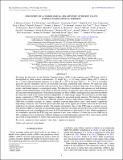DISCOVERY OF A COSMOLOGICAL, RELATIVISTIC OUTBURST VIA ITS RAPIDLY FADING OPTICAL EMISSION
Author(s)
Cenko, S. Bradley; Kulkarni, S. R.; Horesh, Assaf; Corsi, A.; Fox, Derek B.; Carpenter, John; Frail, Dale A.; Nugent, Peter E.; Perley, Daniel A.; Gruber, D.; Gal-Yam, Avishay; Groot, P.; Hallinan, G.; Ofek, Eran O.; Rau, Arne; MacLeod, Chelsea L.; Miller, Adam A.; Bloom, Joshua S.; Filippenko, Alexei V.; Kasliwal, Mansi M.; Law, Nicholas M.; Morgan, Adam N.; Polishook, David; Poznanski, Dovi; Quimby, Robert M.; Sesar, Branimir; Shen, Ken J.; Silverman, Jeffrey M.; Sternberg, Assaf; ... Show more Show less
DownloadCenko-2013-DISCOVERY OF A COSMO.pdf (1.018Mb)
PUBLISHER_POLICY
Publisher Policy
Article is made available in accordance with the publisher's policy and may be subject to US copyright law. Please refer to the publisher's site for terms of use.
Terms of use
Metadata
Show full item recordAbstract
We report the discovery by the Palomar Transient Factory (PTF) of the transient source PTF11agg, which is distinguished by three primary characteristics: (1) bright (R[subscript peak] = 18.3 mag), rapidly fading (ΔR = 4 mag in Δt = 2 days) optical transient emission; (2) a faint (R = 26.2 ± 0.2 mag), blue (g' – R = 0.17 ± 0.29 mag) quiescent optical counterpart; and (3) an associated year-long, scintillating radio transient. We argue that these observed properties are inconsistent with any known class of Galactic transients (flare stars, X-ray binaries, dwarf novae), and instead suggest a cosmological origin. The detection of incoherent radio emission at such distances implies a large emitting region, from which we infer the presence of relativistic ejecta. The observed properties are all consistent with the population of long-duration gamma-ray bursts (GRBs), marking the first time such an outburst has been discovered in the distant universe independent of a high-energy trigger. We searched for possible high-energy counterparts to PTF11agg, but found no evidence for associated prompt emission. We therefore consider three possible scenarios to account for a GRB-like afterglow without a high-energy counterpart: an "untriggered" GRB (lack of satellite coverage), an "orphan" afterglow (viewing-angle effects), and a "dirty fireball" (suppressed high-energy emission). The observed optical and radio light curves appear inconsistent with even the most basic predictions for off-axis afterglow models. The simplest explanation, then, is that PTF11agg is a normal, on-axis long-duration GRB for which the associated high-energy emission was simply missed. However, we have calculated the likelihood of such a serendipitous discovery by PTF and find that it is quite small (≈2.6%). While not definitive, we nonetheless speculate that PTF11agg may represent a new, more common (>4 times the on-axis GRB rate at 90% confidence) class of relativistic outbursts lacking associated high-energy emission. If so, such sources will be uncovered in large numbers by future wide-field optical and radio transient surveys.
Date issued
2013-06Department
Massachusetts Institute of Technology. Department of Earth, Atmospheric, and Planetary SciencesJournal
Astrophysical Journal
Publisher
Institute of Physics/American Astronomical Society
Citation
Cenko, S. Bradley, S. R. Kulkarni, Assaf Horesh, Alessandra Corsi, Derek B. Fox, John Carpenter, Dale A. Frail, et al. “DISCOVERY OF A COSMOLOGICAL, RELATIVISTIC OUTBURST VIA ITS RAPIDLY FADING OPTICAL EMISSION.” The Astrophysical Journal 769, no. 2 (May 14, 2013): 130. © 2013 American Astronomical Society.
Version: Final published version
ISSN
0004-637X
1538-4357